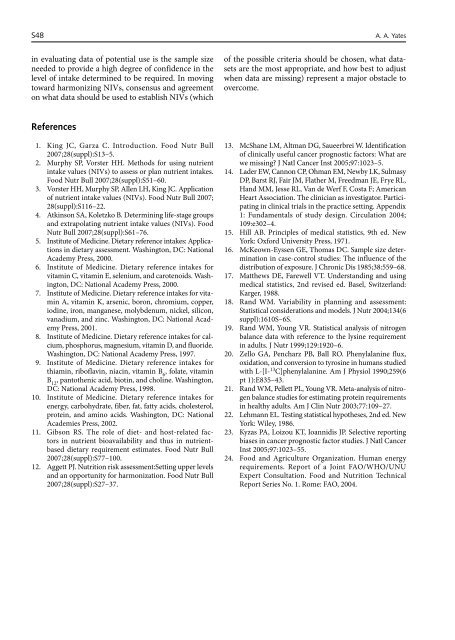Implementing food-based dietary guidelines for - United Nations ...
Implementing food-based dietary guidelines for - United Nations ...
Implementing food-based dietary guidelines for - United Nations ...
Create successful ePaper yourself
Turn your PDF publications into a flip-book with our unique Google optimized e-Paper software.
S48<br />
in evaluating data of potential use is the sample size<br />
needed to provide a high degree of confidence in the<br />
level of intake determined to be required. In moving<br />
toward harmonizing NIVs, consensus and agreement<br />
on what data should be used to establish NIVs (which<br />
References<br />
1. King JC, Garza C. Introduction. Food Nutr Bull<br />
2007;28(suppl):S13–5.<br />
2. Murphy SP, Vorster HH. Methods <strong>for</strong> using nutrient<br />
intake values (NIVs) to assess or plan nutrient intakes.<br />
Food Nutr Bull 2007;28(suppl):S51–60.<br />
3. Vorster HH, Murphy SP, Allen LH, King JC. Application<br />
of nutrient intake values (NIVs). Food Nutr Bull 2007;<br />
28(suppl):S116–22.<br />
4. Atkinson SA, Koletzko B. Determining life-stage groups<br />
and extrapolating nutrient intake values (NIVs). Food<br />
Nutr Bull 2007;28(suppl):S61–76.<br />
5. Institute of Medicine. Dietary reference intakes: Applications<br />
in <strong>dietary</strong> assessment. Washington, DC: National<br />
Academy Press, 2000.<br />
6. Institute of Medicine. Dietary reference intakes <strong>for</strong><br />
vitamin C, vitamin E, selenium, and carotenoids. Washington,<br />
DC: National Academy Press, 2000.<br />
7. Institute of Medicine. Dietary reference intakes <strong>for</strong> vitamin<br />
A, vitamin K, arsenic, boron, chromium, copper,<br />
iodine, iron, manganese, molybdenum, nickel, silicon,<br />
vanadium, and zinc. Washington, DC: National Academy<br />
Press, 2001.<br />
8. Institute of Medicine. Dietary reference intakes <strong>for</strong> calcium,<br />
phosphorus, magnesium, vitamin D, and fluoride.<br />
Washington, DC: National Academy Press, 1997.<br />
9. Institute of Medicine. Dietary reference intakes <strong>for</strong><br />
thiamin, riboflavin, niacin, vitamin B 6 , folate, vitamin<br />
B 12 , pantothenic acid, biotin, and choline. Washington,<br />
DC: National Academy Press, 1998.<br />
10. Institute of Medicine. Dietary reference intakes <strong>for</strong><br />
energy, carbohydrate, fiber, fat, fatty acids, cholesterol,<br />
protein, and amino acids. Washington, DC: National<br />
Academies Press, 2002.<br />
11. Gibson RS. The role of diet- and host-related factors<br />
in nutrient bioavailability and thus in nutrient<strong>based</strong><br />
<strong>dietary</strong> requirement estimates. Food Nutr Bull<br />
2007;28(suppl):S77–100.<br />
12. Aggett PJ. Nutrition risk assessment:Setting upper levels<br />
and an opportunity <strong>for</strong> harmonization. Food Nutr Bull<br />
2007;28(suppl):S27–37.<br />
A. A. Yates<br />
of the possible criteria should be chosen, what datasets<br />
are the most appropriate, and how best to adjust<br />
when data are missing) represent a major obstacle to<br />
overcome.<br />
13. McShane LM, Altman DG, Saueerbrei W. Identification<br />
of clinically useful cancer prognostic factors: What are<br />
we missing? J Natl Cancer Inst 2005;97:1023–5.<br />
14. Lader EW, Cannon CP, Ohman EM, Newby LK, Sulmasy<br />
DP, Barst RJ, Fair JM, Flather M, Freedman JE, Frye RL,<br />
Hand MM, Jesse RL, Van de Werf F, Costa F; American<br />
Heart Association. The clinician as investigator. Participating<br />
in clinical trials in the practice setting. Appendix<br />
1: Fundamentals of study design. Circulation 2004;<br />
109:e302–4.<br />
15. Hill AB. Principles of medical statistics, 9th ed. New<br />
York: Ox<strong>for</strong>d University Press, 1971.<br />
16. McKeown-Eyssen GE, Thomas DC. Sample size determination<br />
in case-control studies: The influence of the<br />
distribution of exposure. J Chronic Dis 1985;38:559–68.<br />
17. Matthews DE, Farewell VT. Understanding and using<br />
medical statistics, 2nd revised ed. Basel, Switzerland:<br />
Karger, 1988.<br />
18. Rand WM. Variability in planning and assessment:<br />
Statistical considerations and models. J Nutr 2004;134(6<br />
suppl):1610S–6S.<br />
19. Rand WM, Young VR. Statistical analysis of nitrogen<br />
balance data with reference to the lysine requirement<br />
in adults. J Nutr 1999;129:1920–6.<br />
20. Zello GA, Pencharz PB, Ball RO. Phenylalanine flux,<br />
oxidation, and conversion to tyrosine in humans studied<br />
with L-[I- 13 C]phenylalanine. Am J Physiol 1990;259(6<br />
pt 1):E835–43.<br />
21. Rand WM, Pellett PL, Young VR. Meta-analysis of nitrogen<br />
balance studies <strong>for</strong> estimating protein requirements<br />
in healthy adults. Am J Clin Nutr 2003;77:109–27.<br />
22. Lehmann EL. Testing statistical hypotheses, 2nd ed. New<br />
York: Wiley, 1986.<br />
23. Kyzas PA, Loizou KT, Ioannidis JP. Selective reporting<br />
biases in cancer prognostic factor studies. J Natl Cancer<br />
Inst 2005;97:1023–55.<br />
24. Food and Agriculture Organization. Human energy<br />
requirements. Report of a Joint FAO/WHO/UNU<br />
Expert Consultation. Food and Nutrition Technical<br />
Report Series No. 1. Rome: FAO, 2004.




